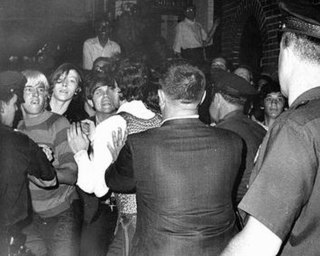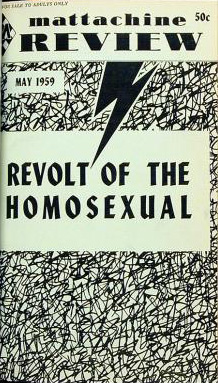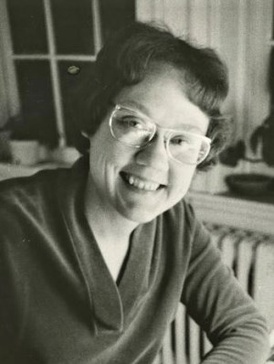Related Research Articles

The Stonewall riots, also known as the Stonewall uprising, Stonewall rebellion, Stonewall revolution, or simply Stonewall, were a series of spontaneous, violent demonstrations against a police raid that took place in the early morning hours of June 28, 1969, at the Stonewall Inn, in the Greenwich Village neighborhood of New York City. Although the demonstrations were not the first time American homosexuals fought back against government-sponsored persecution of sexual minorities, the Stonewall riots marked a new beginning for the gay rights movement in the United States and around the world.

The Mattachine Society, founded in 1950, was an early national gay rights organization in the United States, preceded by several covert and open organizations, such as Chicago's Society for Human Rights. Communist and labor activist Harry Hay formed the group with a collection of male friends in Los Angeles to protect and improve the rights of gay men. Branches formed in other cities, and by 1961 the Society had splintered into regional groups.

Dorothy Louise Taliaferro "Del" Martin and Phyllis Ann Lyon were an American lesbian couple based in San Francisco who were known as feminist and gay-rights activists.

The Daughters of Bilitis, also called the DOB or the Daughters, was the first lesbian civil and political rights organization in the United States. The organization, formed in San Francisco in 1955, was initially conceived as a secret social club, an alternative to lesbian bars, which were subject to raids and police harassment.

The Ladder was the first nationally distributed lesbian publication in the United States. Published from 1956 to 1972, The Ladder was the primary monthly publication and method of communication for the Daughters of Bilitis (DOB), the first lesbian organization in the US. It was supported by ONE, Inc. and the Mattachine Society, with whom the DOB retained friendly relations. The name of the magazine was derived from the artwork on its first cover, simple line drawings showing figures moving towards a ladder that disappeared into the clouds.

Barbara Gittings was a prominent American activist for LGBT equality. She organized the New York chapter of the Daughters of Bilitis (DOB) from 1958 to 1963, edited the national DOB magazine The Ladder from 1963 to 1966, and worked closely with Frank Kameny in the 1960s on the first picket lines that brought attention to the ban on employment of gay people by the largest employer in the US at that time: the United States government. Her early experiences with trying to learn more about lesbianism fueled her lifetime work with libraries. In the 1970s, Gittings was most involved in the American Library Association, especially its gay caucus, the first such in a professional organization, in order to promote positive literature about homosexuality in libraries. She was a part of the movement to get the American Psychiatric Association to drop homosexuality as a mental illness in 1972. Her self-described life mission was to tear away the "shroud of invisibility" related to homosexuality, which had theretofore been associated with crime and mental illness.
This is a list of notable events in the history of LGBT rights that took place in the 1960s.
The Tavern Guild was an association of gay bar owners and liquor wholesalers that formed in 1962 in San Francisco, California, and lasted until 1995.
The North American Conference of Homophile Organizations was an umbrella organization for a number of homophile organizations. Founded in 1966, the goal of NACHO was to expand coordination among homophile organizations throughout the Americas. Homophile activists were motivated in part by an increase in mainstream media attention to gay issues. Some feared that without a centralized organization, the movement would be hijacked, in the words of founding member Foster Gunnison Jr., by "fringe elements, beatniks, and other professional non-conformists".
Herbert Donaldson was an openly gay San Francisco lawyer and judge who gained national attention for his efforts to legally block San Francisco police from harassing attendees of a fund-raising ball for the Council on Religion and the Homosexual, an early homophile organization, on January 1, 1965.
Evander Smith was an openly gay San Francisco lawyer who gained national attention for his efforts to legally block San Francisco police from harassing attendees of a fund-raising ball held by the Council on Religion and the Homosexual, an early homophile organization, on January 1, 1965.

The lesbian, gay, bisexual and transgender (LGBT) community in San Francisco is one of the largest and most prominent LGBT communities in the United States, and is one of the most important in the history of American LGBT rights and activism alongside New York City. The city itself has been described as "the original 'gay-friendly city'". LGBT culture is also active within companies that are based in Silicon Valley, which is located within the southern San Francisco Bay Area.
Helen Jane "Sandy" Sandoz, also known by her pseudonym Helen Sanders, was an American lesbian rights activist and writer. She was involved in the Daughters of Bilitis and its official publication, The Ladder, from 1956 to 1970.
Stella Rush, also known by her pen name Sten Russell, was an American journalist and LGBT rights activist. She was a regular reporter for the gay rights magazine ONE (1954–1961) and the lesbian rights magazine The Ladder (1957–1968).

Shirley Willer was an American feminist and activist. Born in Chicago, Illinois, Willer joined the Daughters of Bilitis (DOB) in the 1950s and became the president of the organization a few years after. Because of her energy and dedication, she helped to revolutionize the homophile movement in the 1960s and helped pave the way for future civil rights advancements for the gay community.
The Tay-Bush Inn raid was a police raid on an all-night, one-room café in San Francisco, California around 3 a.m. on September 14, 1961. There 103 LGBT patrons were arrested. It is considered a pivotal event in the history of LGBT rights in San Francisco. It was the largest raid on a gay bar in this city, and received the most press coverage. The arrested were described in the press as mostly white and middle class men.
The National LGBTQ Wall of Honor is a memorial wall in the Greenwich Village neighborhood of Manhattan in New York City, dedicated to LGBTQ "pioneers, trailblazers, and heroes". Located inside the Stonewall Inn, the wall is part of the Stonewall National Monument, the first U.S. National Monument dedicated to the country's LGBTQ rights and history. The first fifty inductees were unveiled June 27, 2019, as a part of events marking the 50th anniversary of Stonewall. Five honorees are added annually.
Billye Talmadge, also known as Billie Tallmij, was a lesbian American activist and educator at the forefront of the burgeoning gay liberation movement in the 1950-60s as well as a founding member of the Daughters of Bilitis, the first organization established to fight explicitly for lesbian civil and political rights in the United States. Her main focus was empowering lesbian youth through education and counseling at a time when many homosexual and lesbian voices had been silenced by the current social and political climate.

California Hall, originally named Das Deutsche Haus, is a historic commercial building and event venue built in 1912, located in the Polk Gulch/Tenderloin neighborhood in San Francisco, California.
Pat Walker was a lesbian activist, poet, and businesswoman, best known for her involvement in the Daughters of Bilitis. She served as the president of the San Francisco chapter of the Daughters of Bilitis and helped create the Council on Religion and the Homosexual.
References
- 1 2 Licata, Salvatore J.; Robert P. Peterson (1982). Historical Perspectives on Homosexuality. Routledge. p. 175. ISBN 0-917724-27-5.
- ↑ Gallo, Marcia M. (September 8, 2007). Different Daughters: A History of the Daughters of Bilitis and the Rise of the Lesbian Rights Movement (PDF). Seal Press. ISBN 978-1580052528.
- ↑ Squatriglia, Chuck; Heredia, Christopher; Writers, Chronicle Staff (2003-09-25). "Donald Stewart Lucas -- gay rights pioneer / He helped build foundation for later activists". SFGate. Retrieved 2019-10-08.
- 1 2 3 4 5 6 Miller, Neil (1995). Out of the Past: Gay and Lesbian History from 1869 to the present. New York: Vintage Books. pp. 348. ISBN 978-0679749882.
- ↑ Cain, Patricia A. (Oct 1993). "Litigating for Lesbian and Gay Rights: A Legal History". Virginia Law Review. 79 (7 Symposium on Sexual Orientation and the Law): 1551–1641. doi:10.2307/1073382. JSTOR 1073382.